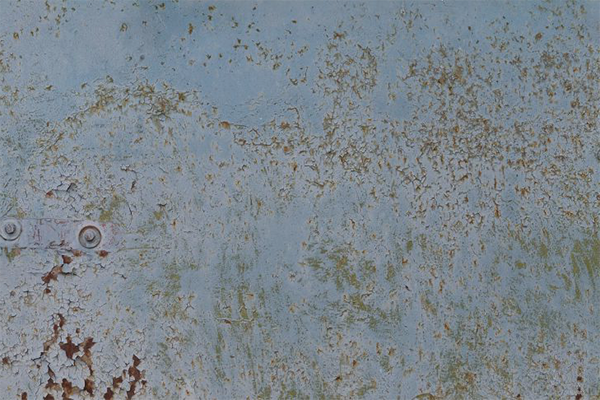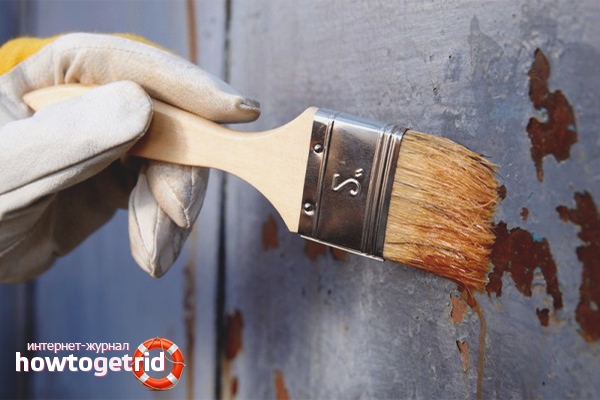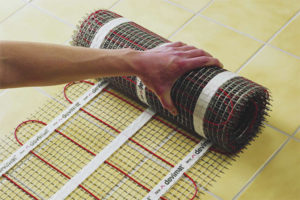The content of the article
Gates or water pipes, covered with a layer of water-based or oil paint, look neat and presentable. Suspensions perform both decorative and protective function, preventing rust. But metal surfaces are regularly in contact with oxygen, which triggers chemical reactions that destroy paint film. It loses anti-corrosion properties, and you have to remove the old cracked layer.
Precautions and simple method
Some metal products are quite fragile, so they can not be handled with a blowtorch or cleaned with tools with abrasive components. Others perfectly tolerate hard brushes, sandpaper and even a building dryer. The method of removing the protective suspension is chosen depending on the thickness and composition of the base, as well as the varieties of the paint itself.
The most economical way is mechanical.You will need a non-stiff stainless steel spatula or a kitchen knife. The main thing is that the tool has a sharp blade.
The painted surface is carefully examined and a weak spot is found where the coating is swollen or cracked. The protective layer is picked up by the selected tool and removed, trying to capture rust, if any.
The second stage of the mechanical method is grinding. Need to arm a coarse sandpaper with water-repellent properties. If you take a simple variety, it will quickly erase and become unusable.
The workpiece is fixed on a bar of hard plastic or wood, to make it easier to grind the metal and align. The base, which is treated with sandpaper, moistened with cold water. It is advisable to use a spray gun so that the liquid is evenly distributed over the subject. Water provides an abrasive surface slip and does not allow particles of dirt and rust to rise into the air.
Repair work will be delayed for a long time, if you have to clean the iron gate or fence. In such situations, the spatula is replaced with a grinder or a drill. You will need a nozzle with stiff fibers.They put it on a power tool and grind a cast iron or iron product until the protective suspension layer disappears.
The result is fixed with anticorrosive impregnations, which fill small cracks and chips left after mechanical cleaning. Items that are planning to re-paint, always treated with a primer.
The method has several significant drawbacks:
- Drill or spatula leaves dents on thin-walled items.
- Eaten paint is difficult to remove mechanically.
- While working in the air raises dust, consisting of an old coating, particles of metal and rust. If a person does not use a respirator and goggles, the substance gets on the mucous membrane of the eyes and nasopharynx, causing irritation.
If you need to clean large items with thick walls, such as pipes, it is recommended to call a specialist with sandblasting equipment. The metal surface is treated with a stream of fine abrasive, which removes both paint and rust.
Removal of old brass coating
Door handles, iron plates, hooks and other accessories clean neatly,so as not to spoil. The old coating is first soaked, and then removed mechanically.
It will take:
- ceramic pan;
- detergent;
- kitchen or office knife;
- nylon brush;
- kitchen tongs;
- screwdriver.
Knife to hook the plate, hold the blade between the fittings and the door. Turn off the screws, remove the handle. Screw hats cleaned with a knife or brush. You can use paint thinner or methylene chloride.
Metal accessories to put in the pan. Pour some water so that it covers the handle and plate. Add 2 spoons of detergent. Put the accessories on the stove and turn on the middle fire. Boil for 4–5 hours, then turn off and leave the pot on the hob until morning.
Paint during this time will soften. Accessories get out of the water kitchen tongs. The coating is removed with a nylon brush. Metal does not fit, it is too hard and leaves scratches on the handle. If the paint is frozen and poorly separated, the accessories are immersed in hot water for 5–10 minutes.
After cleaning, brass products are polished with a soft cloth and beeswax to protect against rust.Before painting, the handle and plate are degreased, a layer of primer and new coating is applied.
Chemical options
Metal objects with a relief surface are treated with solvents. They are:
- universal;
- substances for ferrous and non-ferrous metals;
- multifunctional, paint remover with putty and primer;
- oil-based coating removers.
Tip: Buy a wash better in the hardware store. Powders and emulsions for removing paint from metal are sold in automobile shops, but there they are two to three times more expensive.
Solvents soften the old coating, but it will be necessary to separate it from the base with a brush with stiff bristles or a spatula. A person who chooses a chemical method should wear a respirator, goggles and rubber gloves. You will need a special suit and shoes.
The wash is applied in a thick layer using a brush. The paint is removed in several stages:
- The metal surface is wiped with a damp cloth, cleared of dirt, then disinfected.
- Treat the prepared object with a solvent, cover with a polyethylene film so that the substance is better absorbed into the old coating.
- Spot 5–20 minutes. The time depends on the type of washing and the thickness of the paint layer.
- The soft coating is torn off with a spatula and swept into a pile, so as not to trample into the ground or floor.
- Remnants of paint removed with a stiff brush with a metallic pile.
The surface must be wiped with special compounds, for example, mineral kerosene, to remove the solvent. The substance should not be left on a metal base, otherwise a new layer of paint will not be able to consolidate and will disappear.
Acetone can soften the old coating. Liquid is impregnated with a cloth or gauze, applied to a metal surface. From above stick with a polyethylene film, fix a design an adhesive tape. Leave on for 10–12 hours for the acetone to absorb and start working. The fabric is removed gradually, immediately cleans the paint so that it does not have time to harden.
The cleaned surface is coated with an anti-corrosion primer. Some aggressive compounds destroy metal objects and provoke rust.
Thermal method
To remove several layers of stubborn paint will help a blowtorch, a building dryer or a gas burner.The metal surface is washed, removing dust and dirt, and after drying it is treated with a fire or jet of hot air.
High temperatures soften the old coating. It is separated from the metal surface, bubbles appear. Heated paint immediately removed with a spatula or a knife. In the left hand you need to hold a blowtorch, and the right to strip off the coating. You can work together to finish faster.
There should be no flammable objects made of wood, paper or fabric near the surface to be treated. The paint is removed carefully so that hot particles do not get on the skin. The softened coating eats into the epithelium and remains a burn that does not heal for a long time.
Do not burn cast iron or brass products. Some varieties of metal are covered with scale, become brittle and collapse after being treated with a blowtorch. On others there are cracks from uneven heating. Do not use a gas burner or a building dryer indoors. The paint emits toxic substances, so the work is carried out on the street or in a ventilated room.
Remove the layer of the old coating quickly and efficiently by mechanical or chemical means.Washes and brushes do not destroy metal surfaces, do not leave dents and cracks. The thermal variant is rarely used and it is necessary to weigh all the minuses and advantages of such purification.
Video: how to remove old paint from a metal surface













To send